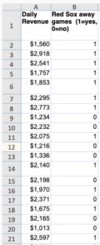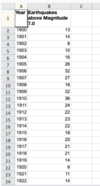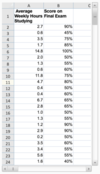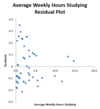Module 4 – Single Variable Linear Regression Flashcards
(46 cards)
Given the regression equation, Selling Price = 13,490.45 + 255.36(HouseSize) Selling Price = 13,490.45 + 255.36(HouseSize), what do you expect the selling price of a 900 square foot home to be?

The expected selling price of a 900 square foot home is B15+B16*900=$243,314.45. You must link directly to the values in order to obtain the correct answer.
Do you feel confident of the prediction you just made for a 900 square foot house, given the data available?
- Yes
- No

Yes
900 lies well within the range of our historical housing data, so we can feel relatively comfortable with this prediction.
No
See correct answer for explanation.
Given the regression equation, Selling Price = 13,490.45 + 255.36(HouseSize), where House Size is measured in square feet, what happens to the average selling price (in dollars) for houses whose size are increased by 500 square feet?
- Average selling price would remain the same
- Average selling price would increase by approximately $255
- Average selling price would increase by approximately $13,490
- Average selling price would increase by approximately $12,750
- Average selling price would increase by approximately $127,500
Average selling price would remain the same
The average selling price would remain the same when house size increases only if the coefficient for House Size were equal to zero, that is, if the regression line’s slope were equal to zero, then the regression line would be flat. In that case, there would be no expected change in selling price for any increase or decrease in the house size. The slope of our regression line, about 255 dollars/square foot, describes the expected change in price when house size increases by one square foot. If house size increases by 500 square feet, how much will the average price increase?
Average selling price would increase by approximately $255
The slope of our regression line, about 255 dollars/square foot, describes the expected change in price when house size increases by one square foot. If house size increases by 500 square feet, how much will the average price increase?
Average selling price would increase by approximately $13,490
The y-intercept of our regression equation is approximately $13,490. The slope of our regression line, about 255 dollars/square foot, describes the expected change in price when house size increases by one square foot. If house size increases by 500 square feet, how much will the average price increase?
Average selling price would increase by approximately $12,750
The slope of our regression line, about 255 dollars/square foot, describes the expected change in price when house size increases by one square foot. If house size increases by 500 square feet, how much will the average price increase?
Average selling price would increase by approximately $127,500
The slope of our regression line, about 255 dollars/square foot, describes the expected change in price when house size increases by one square foot. If the square footage increased by a factor of 500, the expected price must also increase by a factor of 500. Therefore, the average increase in price as square footage increases by 500 square feet is 500($255)=$127,500.
Which of the following p-values would indicate that we can be 95% confident that there is a significant linear relationship between two variables? Select all that apply.
- 0.0025
- 0.0100
- 0.9500
- 0.9750
0.0025
We reach a specified level of confidence when our p-value is less than 1-confidence level. Since the p-value, 0.0025, is less than 1-0.95=0.05, we can be 95% confident that there is a significant linear relationship. Note that another option is also correct.
0.0100
We reach a specified level of confidence when our p-value is less than 1-confidence level. Since the p-value, 0.0100, is less than 1-0.95=0.05, we can be 95% confident that there is a significant linear relationship. Note that another option is also correct.
0.9500
We reach a specified level of confidence when our p-value is less than 1-confidence level. The p-value, 0.9500, is greater than 1-0.95=0.05 so we cannot be confident that there is a significant linear relationship.
0.9750
We reach a specified level of confidence when our p-value is less than 1-confidence level. The p-value, 0.9750, is greater than 1-0.95=0.05 so we cannot be confident that there is a significant linear relationship.
The spreadsheet below contains a partial view of data about U.S. corn acreage planted (in millions of acres) and the amount of corn (in millions of bushels) in storage from the previous year at the beginning of the year for each year from 1976 to 2013.
We wish to use the data to predict the number of acres of corn that will be planted, based on the beginning corn stock in storage. Which variable is the independent variable?
- Corn Acreage Planted (in million acres)
- Stock of Corn at Start of Year (in million bushels)

Stock of Corn at Start of Year (in million bushels)
“Stock of Corn at Start of Year” is the independent variable, and “Corn Acreage Planted” is the dependent variable. The beginning stock of corn at the start of the year will be used to predict the number of acres of corn that are planted.
Given the regression equation, Selling Price=$13,490.45+$255.36(House Size), what happens to the average selling price (in dollars) for houses whose size are decreased by 1000 square feet?
- Average selling price would decrease by approximately $268,490
- Average selling price would increase by approximately $268,490
- Average selling price would decrease by approximately $255,000
- Average selling price would increase by approximately $255,000
Average selling price would decrease by approximately $268,490
The slope of our regression line, about 255 dollars/square foot, describes the expected change in price when house size increases by one square foot. If house size decreases by 1,000 square feet, how much will the average price decrease?
Average selling price would increase by approximately $268,490
The slope of our regression line, about 255 dollars/square foot, describes the expected change in price when house size increases by one square foot. If house size decreases by 1,000 square feet, how much will the average price decrease?
Average selling price would decrease by approximately $255,000
The slope of our regression line, about 255 dollars/square foot, describes the expected change in price when house size increases by one square foot. If the square footage decreased by a factor of 1,000, the expected price must also decrease by a factor of 1,000. Therefore, the average decrease in price as square footage decreases by 1,000 square feet is -1,000($255) =-$255,000.
Average selling price would increase by approximately $255,000
The slope of our regression line, about 255 dollars/square foot, describes the expected change in price when house size increases by one square foot. If house size decreases by 1,000 square feet, average selling price will also decrease.
Postive, Negative, or Zero slope?
AS X INCREASES, Y DOES NOT CHANGE.
Zero

Postive, Negative, or Zero slope?
AS X INCREASES, Y DECREASES.
Negative

Postive, Negative, or Zero slope?
AS X INCREASES, Y INCREASES.
Positive

Create a Dummy variable or not?
DIRECTION (NORTH, SOUTH, EAST, AND WEST)
Dummy
Variables that can be sorted or grouped into categories must be transformed into dummy variables. Note that numerical values sometimes represent a qualitative/categorical variable, requiring the use of a dummy variable.
Create a Dummy variable or not?
TEMPERATURE (IN DEGREES CELSIUS)
No
Variables that can be counted or measured and that are naturally represented as numbers do not need to be represented as a dummy variable.
Create a Dummy variable or not?
VOLUME (IN CUBIC METERS)
Not
Variables that can be counted or measured and that are naturally represented as numbers do not need to be represented as a dummy variable.
Create a Dummy variable or not?
COUNTRY TELEPHONE CODE
Yes
Variables that can be sorted or grouped into categories must be transformed into dummy variables. Note that numerical values sometimes represent a qualitative/categorical variable, requiring the use of a dummy variable.
A p-value to test the significance of a linear relationship between two variables was calculated to be 0.0210. What can we conclude? Select all that apply
- We can be 90% confident that there is a significant linear relationship between the two variables.
- We can be 95% confident that there is a significant linear relationship between the two variables.
- We can be 98% confident that there is a significant linear relationship between the two variables.
- We can be 99% confident that there is a significant linear relationship between the two variables.
We can be 90% confident that there is a significant linear relationship between the two variables.
Since the p-value, 0.0210, is less than 1-0.90=0.10, we can be 90% confident that there is a significant linear relationship between the two variables. Note another option is also correct.
We can be 95% confident that there is a significant linear relationship between the two variables.
Since the p-value, 0.0210, is less than 1-0.95=0.05, we can be 95% confident that there is a significant linear relationship between the two variables. Note another option is also correct.
We can be 98% confident that there is a significant linear relationship between the two variables.
Since the p-value, 0.0210, is greater than 1-0.98=0.02, we cannot be 98% confident that there is a significant linear relationship between the two variables.
We can be 99% confident that there is a significant linear relationship between the two variables.
Since the p-value, 0.0210, is greater than 1-0.99=0.01, we cannot be 99% confident that there is a significant linear relationship between the two variables.
Given the regression equation, Selling Price = 13,490.45 + 255.36(HouseSize), what do you expect the selling price of a 425 square foot home to be?

The expected selling price of a 425 square foot home is B15+B16*425=$122,018.45. You must link directly to the values in order to obtain the correct answer.
Do you feel confident of the prediction you just made for a 425 square foot house, given the data available?
- Yes
- No

Yes
See correct answer for explanation.
No
425 square feet lies just outside the range of our historical housing data. Remember that there is greater uncertainty as we forecast outside of the historical range of the data, so we probably should not feel very comfortable with this prediction.
Given the regression equation, Selling Price = 13,490.45 + 255.36 (HouseSize), which of the following values represents the value of Selling Price at which the regression line intersects the vertical axis?
- Selling Price
- $13,490.45
- $255.36
- House Size
Selling Price
Selling Price is the dependent variable in this equation.
$13,490.45
13,490.45 is the y-intercept, the value at which the regression line intersects the y-axis. This happens when House Size = 0, giving the equation: Selling Price = 13,490.45+255.36*0 = 13,490.45
$255.36
255.36 dollars/square foot is the line’s slope, which is equal to the average change in selling price as house size increases by one square foot.
House Size
House Size is the independent variable in this equation.
When analyzing a residual plot, which of the following indicates that a linear model is a good fit?
- Patterns or curves in the residuals
- Increasing size of the residuals as values increase along the x-axis
- Decreasing size of the residuals as values increase along the x-axis
- Random spread of residuals around the y-axis
- Random spread of residuals around the x-axis
Patterns or curves in the residuals
Patterns or curves in the residual plot indicate that the linear model is not a good fit. It is possible that a nonlinear relationship exists between the independent and dependent variable. What characteristics of a residual plot might indicate that a linear model is a good fit?
Increasing size of the residuals as values increase along the x-axis
The size of the residuals should not increase as values increase along the x-axis; this is a sign of heteroskedasticity. What characteristics of a residual plot might indicate that a linear model is a good fit
Decreasing size of the residuals as values increase along the x-axis
The size of the residuals should not decrease as values increase along the x-axis; this is a sign of heteroskedasticity. What characteristics of a residual plot might indicate that a linear model is a good fit?
Random spread of residuals around the y-axis
The y-axis of a residual plot represents the size of the residuals; this is not the axis that we examine. What characteristics of a residual plot might indicate that a linear model is a good fit?
Random spread of residuals around the x-axis
A linear model is a good fit if the residuals are spread randomly above and below the x-axis.
The spreadsheet below contains a partial view of data about U.S. corn acreage planted (in millions of acres) and the amount of corn (in millions of bushels) in storage from the previous year at the beginning of the year for each year from 1976 to 2013.
If you want to include the variables’ labels in the regression output, which cells should you select as the input range for the independent variable?
- Input Y Range, B1:B39
- Input Y Range, B2:B39
- Input X Range, B1:B39
- Input X Range, B2:B39

Input Y Range, B1:B39
The Input Y Range is used to enter the cell reference for the dependent variable, not the independent variable.
Input Y Range, B2:B39
The Input Y Range is used to enter the cell reference for the dependent variable, not the independent variable.
Input X Range, B1:B39
The Input X Range is used to enter the cell reference for the independent variable. The cell reference, B1:B39, correctly includes the column label.
Input X Range, B2:B39
The Input X Range is used to enter the cell reference for the independent variable. The cell reference should include cell B1, since we include the column labels to ensure that our charts are appropriately labeled.
Given the regression equation, Selling Price = 13,490.45 + 255.36 (HouseSize), which of the following values represents the value of House Size at which the regression line intersects the horizontal axis?
- 52.83 square feet
- 13,490.45 square feet
- 255.36 square feet
- The answer cannot be determined without further information.
- 52.83 square feet
The regression line intersects the horizontal axis when Selling Price = $0, that is, when House Size = -52.83 square feet. 13,490.45+ 255.36*(-52.83)=$0.00 (actually, -52.82914, which rounds to -52.83).
13,490.45 square feet
$13,490.45 is the y-intercept, the value at which the regression line intersects the y-axis. This happens when House Size = 0 square feet, giving the equation: Selling Price = 13,490.45+255.36*0 = $13,490.45
- 36 square feet
- 36 dollars/square foot is the line’s slope, which is equal to the average change in selling price as house size increases by one square foot.
The answer cannot be determined without further information.
The regression equation provides us with information about both the slope of the line and the point where the regression lines intersects the horizontal axis.
The linear relationship between two variables can be statistically significant but not explain a large percentage of the variation between the two variables. This would correspond to which pair of R^2 and p-value?
- Low R-squared, Low p-value
- Low R-squared, High p-value
- High R-squared, Low p-value
- High R-squared, High p-value
Low R-squared, Low p-value
A low R-squared and low p-value indicates that the independent variable explains little variation in the dependent variable and the linear relationship between the two variables is significant.
Low R-squared, High p-value
A low R-squared and high p-value indicates that the independent variable explains little variation in the dependent variable and the linear relationship between the two variables is not significant.
High R-squared, Low p-value
A high R-squared and low p-value indicates that the independent variable explains a lot of the variation in the dependent variable and the linear relationship between the two variables is significant.
High R-squared, High p-value
A high R-squared and high p-value indicates that the independent variable explains a lot of the variation in the dependent variable and the linear relationship between the two variables is not significant.
Given the regression equation, Selling Price = 13,490.45 + 255.36 (HouseSize), what do you expect the selling price of a 3,500 square foot home to be?

The expected selling price of a 3,500 square foot home is B15+B16*3500=$907,250.45. You must link directly to the values in order to obtain the correct answer.
Do you feel confident of the prediction you just made for a 3,500 square foot house, given the data available?
- Yes
- No

Yes
3,500 lies well within the range of our historical housing data, so we can feel relatively comfortable with this prediction.
No
See correct answer for explanation.
Which of the following 95% confidence intervals for a regression line’s slope indicates that the linear relationship is NOT significant at the 5% level? Select all that apply.
- -9.85; -5.26
- -9.85; 5.26
- -5.26; 9.85
- 5.26; 9.85
-9.85; -5.26
Remember that the 95% confidence interval of the slope must contain zero to indicate that the linear relationship is not significant at the 5% level. The confidence interval boundaries, -9.85 and -5.26 are both negative, so this range does not contain zero.
-9.85; 5.26
The range between -9.85 and 5.26 contains zero, which indicates that the linear relationship is not significant at the 5% level. Note that another option is also correct.
-5.26; 9.85
The range between -5.26 and 9.85 contains zero, which indicates that the linear relationship is not significant at the 5% level. Note that another option is also correct.
5.26; 9.85
Remember that the 95% confidence interval of the slope must contain zero to indicate that the linear relationship is not significant at the 5% level. The confidence interval boundaries, 5.26 and 9.85 are both positive, so this range does not contain zero.























